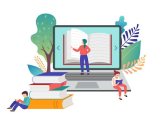Headteacher Maggie Rose tells TEY how forest school training with the Forest School Learning Initiative has benefited her children…
MR: I’ve been at Timberley for 16 years now. I started as a maths coordinator, then became a deputy head, and have now been head for six years. We have a 78-place nursery class at the school, with four members of early years staff. Our children start in the first term after they’re three, so some of them are with us for five terms before they enter Reception.
MR: I’ve taken two courses with them – Forest School Leaders and First Aid outside. I took my training two years ago. I hadn’t had any background with forest school before that, but I had an interest in outdoor education, and I liked the approach of learning by discovery, letting the children drive the learning. The FSLI seemed to be a perfect fit for the way we wanted our children to learn.
The course I took lasted six days – we had time spent in the classroom, working with children, then two days where we taught skills, and a two-day assessment. Since completing my training, I’ve trained five members of staff, who work with children across the school.
We have a forest school on site. It’s a large area where we’ve planted lots of trees, as well as holly bushes and other things to break it up. There’s grass of different kinds and levels, a seating circle where children can sit, and a fire-pit. We’ve tried to create an area in which the children feel like they’re in a real forest.
MR: We give the children blocks of sessions. So, for example, they’ll go out for an afternoon, for two hours, and have six sessions over the course of six weeks. They could be doing anything, but as we’re in an area that’s quite language deprived, our focus is often on the language work we’re going to get from the children, as well as encouraging them to work together as part of a team.
We might start out with an activity where they have to hide and we’ll go and look for them, just to get them used to all of the areas and let them have a good explore. After that we won’t necessarily choose activities for the children; we’ll put things out for them to do. So, there might be paintbrushes out so they can paint in the mud; there’s a sandpit there they can dig in – they search for treasure, we ask them to find different objects and bring them back and describe them to us. Basically, the sky’s the limit. It’s very much child-led – the more child-led the session, the better. Teachers might lead an activity, but if the children don’t want to do it they can get involved in an activity they’ve chosen for themselves.
MR: I can give the FSLI a glowing recommendation – all of my children look forward to forest school sessions. It’s a brilliant initiative as it really does give children the feeling that they can try anything, even though it’s part of a safe environment.
The impact it’s had on them has been huge. You might take a child into the forest school area for the first time and they might not be prepared to talk to you because they don’t work with you every day, but by the end of six sessions they’ll be chatting away – they’ve grown in confidence, they’ve grown in self-belief, their language has improved and so has their concentration. They love it.
For more information on the training available from the FSLI, visit forestschoollearning.co.uk

Staff Appraisals
Ace-Owner

“Nurseries Aren’t All Nappies and Nursery Rhymes”
Editors picks

Taking charge of your CPD
Editors picks

The role of the Early Years Professional
Ace-Owner
